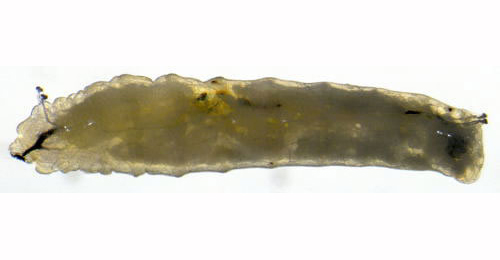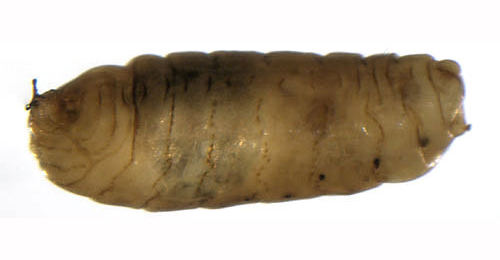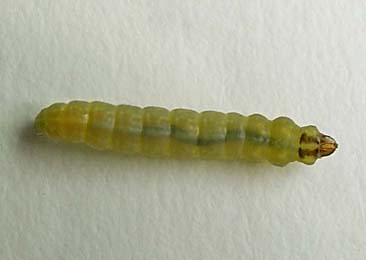|
||||||
|
GLYCERIA. Sweetgrasses. [Poaceae] |
|
Six species of Glyceria are recorded in Britain. Thes include the native Small Sweet-grass (G. declinata), Floating Sweet-grass (G. fluitans), Reed Sweet-grass (G. maxima) and Plicate Sweet-grass (G. notata). The BSBI provide a downloadable plant crib for Glyceria. Fifteen miners are recorded on Glyceria. The larvae of a number of species of Chironomidae (see Cricotopus brevipalpis, Criciotopus tricinctus and Cricotopus trifasciatus) live in tunnels in decaying leaf sheaths under water. Their tunnels are open at both ends, and the larvae feed on particles they obtain from a water current they create in the tunnels. They do not feed on tissues of their 'hostplant' and therefore are not strictly miners. A key to the European miners recorded on Glyceria is provided in Bladmineerders van Europa. Nearly 100 British miners or possible miners are recorded on grasses in Britain. It is recommended that adults of all miners on grasses be reared to be certain of their identity. |
Key for the identification of the known mines of British |
||
Note: Diptera larvae may live in a corridor mine, a corridor-blotch mine, or a blotch mine, but never in a case, a rolled or folded leaf, a tentiform mine or sandwiched between two more or less circular leaf sections in later instars. Pupation never in a cocoon. All mining Diptera larvae are leg-less maggots without a head capsule (see examples). They never have thoracic or abdominal legs. They do not have chewing mouthparts, although they do have a characteristic cephalo-pharyngeal skeleton (see examples), usually visible internally through the body wall. The larvae lie on their sides within the mine and use their pick-like mouthparts to feed on plant tissue. In some corridor miners frass may lie in two rows on alternate sides of the mine. In order to vacate the mine the fully grown larva cuts an exit slit, which is usually semi-circular (see Liriomyza huidobrensis video). The pupa is formed within the hardened last larval skin or puparium and as a result sheaths enclosing head appendages, wings and legs are not visible externally (see examples). See Key to non-Diptera. |
||
1a > Tunneler: The larvae of a number of species of Chironomidae (non-biting midges) live in tunnels in decaying leaf sheaths under water. Their tunnels are open at both ends, and the larvae feed on particles they obtain from a water current they create in the tunnels. They do not feed on tissues of their 'hostplant' and therefore are not strictly miners. |
||
|
||
Cricotopus trifasciatus (Meigen, 1813) [Diptera: Chironomidae] |
||
1b > Tunneler: Half-mine; a one cm long straight tunnel along the midline of the upperside of the leaf; larva rests in this retreat during the day, emerging to devour the upper epidermis of the leaf during the hours of darkness. Feeding occurs from both ends of the retreat to a similar degree (Bland, 1994a). The larvae of a number of species of Chironomidae (non-biting midges) live in tunnels in decaying leaf sheaths under water. Their tunnels are open at both ends, and the larvae feed on particles they obtain from a water current they create in the tunnels. They do not feed on tissues of their 'hostplant' and therefore are not strictly miners. |
||
|
||
Cricotopus tricinctus (Meigen, 1818) [Diptera: Chironomidae]. |
||
1c > Leaf-miner: Larvae feed singly, forming an upper surface linear-blotch mine. Pupation either internal or external, with the puparium loosely glued to the leaf (Spencer, 1976: 91). Oviposition near the leaf margin, at some distance from the leaf tip. From there develops an upper-surface corridor-blotch. At first the mine ascends as a narrow corridor towards the leaf tip, then the direction turns and the mine, steadily widening, descends in the direction of the leaf base. Frass irregular, in rather coarse grains. Larva solitary. Pupation mostly outside the mine; in that case the puparium often sticks to the leaf. |
||
|
||
|
||
Agromyza albipennis Meigen, 1830 [Diptera: Agromyzidae]. |
||
1d > Leaf-miner: A blotch mine, larvae feeding first towards apex of leaf and then downwards towards base. Pupation external (Spencer, 1976: 95). Long, shallow corridor, initially running up towards the leaf tip, then switching direction and descending. Here and there remain small islands of uneaten leaf parenchyma. Frass in regularly dispersed granules. Pupation outside the mine. |
||
|
||
Agromyza alunulata (Hendel, 1931) [Diptera: Agromyzidae]. |
||
1e > Leaf-miner: Larvae either singly or several in leaf, then forming large blotch-mine, feeding first up and then down the leaf. Pupation external (Spencer, 1976: 119). Shallow upper-surface corridor, without full-depth sections, starting high in the leaf. Initially the corridor runs up, but soon it changes direction, quickly widening. In Deschampsia generally one mine per leaf, occupying its entire width; in Glyceria there mostly are serveral mines that merge in the end. Pupation outside the mine; the puparium often sticks to the leaf. Puparium black or dark red |
||
|
||
Agromyza lucida Hendel, 1920 [Diptera: Agromyzidae]. |
||
1f > Leaf-miner: Larval leaf-mine starts as a narrow channel running towards apex of leaf but later develops into a broad blotch running downwards. Frass largely diffused, giving the mine a characteristic greenish appearance. Pupation external (Spencer, 1976: 126). Corridor, usually several in one leaf, running from close to the leaf base up to near the tip, then reversing direction and widening, resulting in one communal mine in which the larvae descend in a common front. Frass somewhat deliquescent, mine therefore strikingly green. Pupation outside the mine. Neither mine nor larva distinguishable from those of mobilis. Puparium reddish brown |
||
|
||
Agromyza nigrella (Rondani, 1875) [Diptera: Agromyzidae]. |
||
1g > Leaf-miner: Larvae feeding singly, forming a long, widening mine on the upper surface of the leaf, which is generally limited to one side of the leaf. Pupation external, puparium glued to the leaf near the end of the mine (Spencer, 1976: 128). Broad corridor, generally beginning near the leaf margin or close to the leaf tip. Most of the times the mine remains at one side of the midrib. The mine is upper-surface, but has some full depth, translucent spots here and there. Frass in rather regularly scattered grains. Pupation outside the mine. According to Dempewolf (2004a) only the male genitalia enable a reliable discrimination from A. abipennis and A. graminicola. |
||
|
||
| Agromyza nigripes Meigen, 1830 [Diptera: Agromyzidae]. | ||
1h > Leaf-miner: Normally several larvae feed together. Pupation in the mine (Spencer, 1976: 198). Broad elongated blotch. Frass greenish. Larvae generally communal. Pupation within the mine. The black puaria are individially anchored within the mine with a silken thread attached at their rear end. Distinguishable from C. incisa only by means of the larva. |
||
|
||
Cerodontha pygmaea (Meigen, 1830) [Diptera: Agromyzidae]. |
||
1i > Leaf-miner: Long, narrow, whitish mine. Pupation internal (Spencer, 1976: 453); anterior spiracles projecting through the epidermis. Whitish, upper-surface, rather narrow corridor with comparatively large frass grains that are laying further apart than their diameter. Pupation within the mine. The anterior spiracles of the orange-brown puparium penetrate the epidermis. |
||
 Chromatomyia nigra larva, lateral Image: © Willem Ellis (Bladmineerders van Europa) |
||
 Chromatomyia nigra pupa, lateral Image: © Willem Ellis (Bladmineerders van Europa) |
||
|
||
Chromatomyia nigra (Meigen, 1830) [Diptera: Agromyzidae]. |
||
1j > Leaf-miner: Irregular mine, locally shallow, elsewhere much deeper, giving it a mottled appearance. In broadleaved plants the mine often begins as a blotch with stellate extensions, but sometimes as a very fine, shallow corridor. In grasses the mine often begins in the leaf sheath. The frass is very fine-grained, initially scattered, later in aggregates. The egg is deposited on the plant surface, and the empty egg shell remains visible. But the larvae are able to leave their mine and restart elsewhere, thus mines without an egg shell can be found as well. The larva also leaves the mine before pupation. Pupation takes place in a newly made, small, blotch mine without frass; this mine may be made in another plant (species). |
||
|
||
|
||
Hydrellia griseola (Fallén, 1813) [Diptera: Ephydridae]. |
||
1k >Leaf-miner: Flat green corridors in the leaves. The only character to separate this species from Hydrellia griseola is that adult flies of griseola are dusted greyish-white, those of thoracica not dusted, greyish brown (Hering, 1957). |
||
|
||
Hydrellia thoracica Haliday, 1839. [Diptera: Ephydridae]. |
|
Key for the identification of the known mines of British |
Note: The larvae of mining Coleoptera, Hymenoptera and Lepidoptera may live in a corridor mine, a corridor-blotch mine, a blotch mine, a case, a rolled or folded leaf, a tentiform mine or sandwiched between two more or less circular leaf sections in later instars. Larva may pupate in a silk cocoon. The larva may have six legs (although they may be reduced or absent), a head capsule and chewing mouthparts with opposable mandibles (see video of a gracillarid larva feeding). Larvae of Hymenoptera and Lepidoptera usually also have abdominal legs (see examples). Frass, if present, never in two rows. Unless feeding externally from within a case the larva usually vacates the mine by chewing an exit hole. Pupa with visible head appendages, wings and legs which lie in sheaths (see examples). |
1a > Leaf miner / Stem-borer: Narrow gallery in a young leaf. After having mined for some time the larva becomes a borer in the stem or rhizome. The larvae feed inside the stems. |
|
Orthotelia sparganella (Thunberg, 1788) [Lepidoptera: Glyphipterigidae]. |
1b > Leaf-miner: Common reed and similar plants are the larval foodplant. The larva of this species has a peculiar habit of cutting part of a leaf to act as a raft, using this to float on the water to a new foodplant when necessary. Narrow, whitish, rather inflated corridor, sometimes several tens of centimeters long, running towards the leaf sheath. Frass in coarse grains, in a distinct central line. Now and then the larva makes a elongate case from leaf material and uses it to float to another hostplant. The case may stick for some time to the new host. The larva pupates in a stem, after having made an exit hole and closed it with silk. |
|
Donacaula forficella (Thunberg, 1794) [ Lepidoptera: Crambidae]. |
1c > Leaf-miner: Corridor widening while descending from the tip of the leaf. The mine is unusual because the sides are very irregularly scalloped out. Moreover, the mine is not evenly transparent, but rather yellowish green and motly, because the larva leaves patches of parenchyma uneaten, and does not feed full depth. Frass in a few irregular, interrupted length lines. Often 2-3 larvae in a mine. The larvae hibernate in the centre of the mine; after winter they leave their mine and pupate. |
|
Elachista apicipunctella Stainton, 1849 [Lepidoptera: Elachistidae]. |
1d > Leaf-mine: Narrow, whitish (in the end often reddish brown) gallery of several decimeters in length, descending from the leaf tip to within the sheath of the leaf. Frass dispersed. Pupation external. The mine is downwards, towards the stem, and difficult to see. It is initially a pale green and later turns brown. When the larvae reach the water-line, they may then mine upwards or swap leaves (and then mine upwards). The frass is scattered in the mine (which distinguishes it from S.forficella, which has frass in a central strip). Found in the borders of steams, ponds etc.. |
 Larva of Elachista poae Image: © Charlie Strrets (British leafminers) |
|
Elachista poae Stainton, 1855 [Lepidoptera: Elachistidae]. |
1e > Leaf-miner: The mine begins near the leaf tip and descends towards the base. The mine occupies the entire width of the blade. Frass initially scattered, later in an irregular central line. Fully developed mine c. 8 cm long. Probably the larva is capable of leaving its mine and restarting in another leaf. Pupation external. |
|
Elachista pomerana Frey, 1870 [Lepidoptera: Elachistidae]. |
1f > Leaf-miner: When young, the larva mines mainly the leaves or the stem of Sparganium or Nuphar lutea. It hibernates. Later it lives amongst spun leaves just below the surface of the water. Pupation in a white silk cocoon attached to the foodplant at or just below the water-level (Belgian Lepidoptera). Long narrow corridor, on or alongside the midrib. The corridor may descend below the water surface, and does contain frass. After some time the larva cuts itself a case out of the mine, and continues living free, partly under water. |
|
Nymphula nitidulata (Hufnagel, 1767) [Lepidoptera: Crambidae]. |
| Last updated 05-Jul-2019 Brian Pitkin | ||


